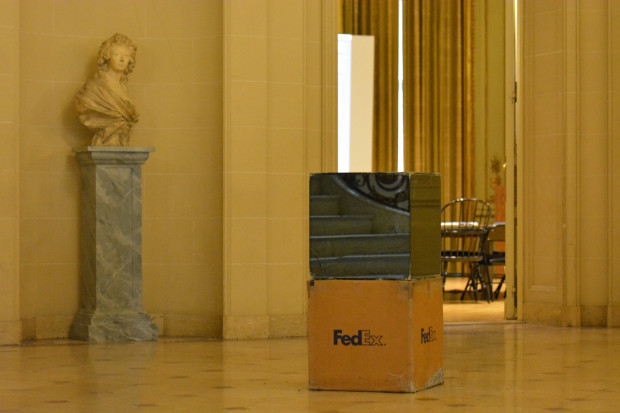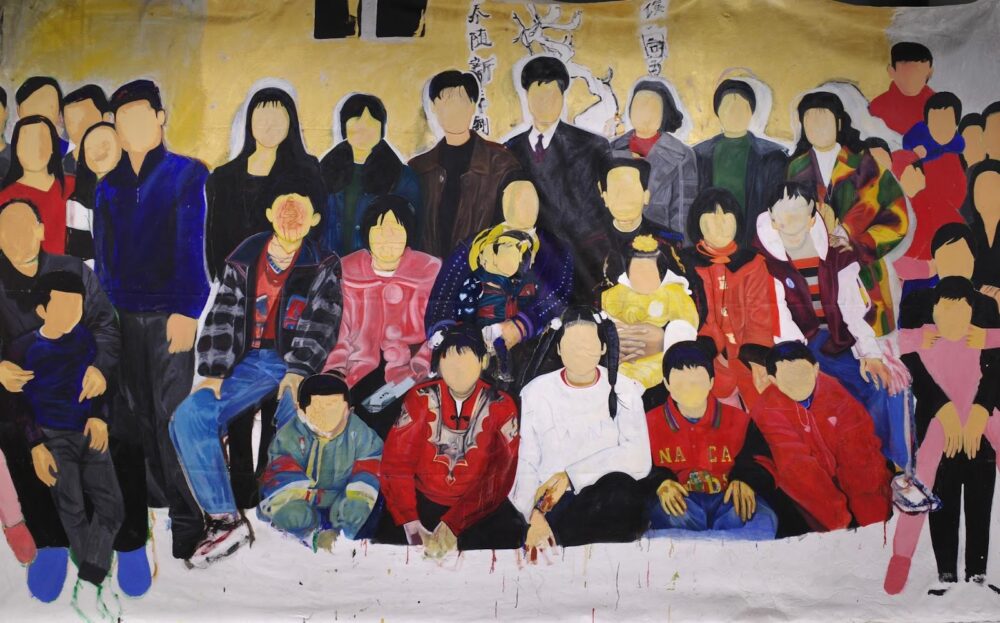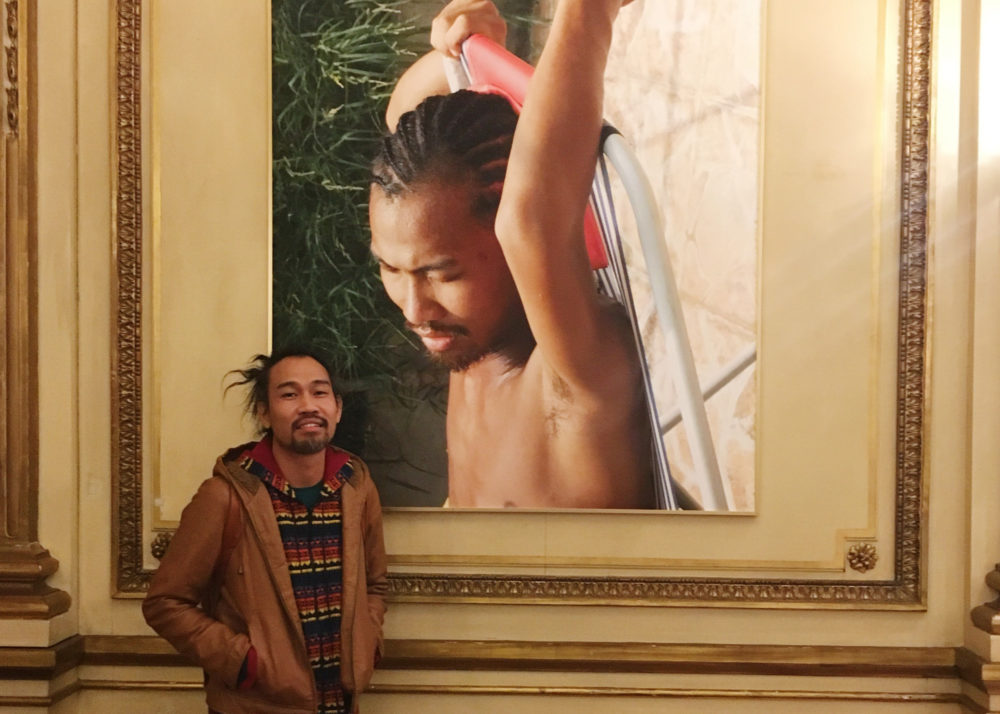This interview was conducted on December 9th, 2021 as part of New York University’s Curatorial Collaborative. This initiative matches BFA students from NYU Steinhardt with… Continue Reading “The Universal in the Personal:” A Conversation with David Ma and Caleb Williams
Posts tagged as “IFA”
In early November, IFA MA student Cindy Qi interviewed Hu Xiangqian, whose work is currently exhibited at the Institute of Fine Arts, NYU as a part of the fall Duke House Exhibition chin(a)frica: an interface, on view through February 18, 2018. Hu Xiangqian (b. 1983) was born in Leizhou, Guangdong Province and graduated in 2007 from Guangzhou Academy of Fine Arts. He currently lives and works in New York City. Hu’s artistic practice is grounded in performance and video works featuring an intentional amateurishness and crudeness. Notable exhibitions include the Gwangju Biennial (2014) and the Shanghai Biennial (2016). A photographic still of his durational performance piece entitled The Sun (2008) hangs in the Institute’s Lecture Hall. The interview was conducted in mandarin Chinese and later translated to English by Cindy Qi.
CQ: Having been in New York for several months now, do you have any discoveries or inspirations you would like to share? Have you decided what kind of work to make during your time here?
来到纽约这几个月你有什么启发或者发现呢?现在有没有构想出想做的作品呢?
HXQ: Yes, I have been preparing to get started in my studio. I live in Brooklyn and in my opinion, it’s a very isolated area that has nothing to do with art, but I like that place. It allows me to distance myself from all that is happening in Manhattan while also having the opportunity to be close to all of it. I really like this feeling of being able to pull away and engage at the same time.
我在我的工作室里准备啊,我现在住的地方比较远,在布鲁克林。 那个地方算是很荒凉的,跟艺术没有什么关系。但是我喜欢那个地方,所以我会在那里做作品。我还挺喜欢这种跟曼哈顿若即若离的感觉。
My interest in inviting Walead Beshty to exhibit at the Institute was rooted in the nature of his work and the questions it raises for the art historical field. Beshty’s commitment to exposing systems, the movement and handling of works of art and the evolving meaning of the art object engenders timely and critical questions that challenge how we interact with, write about, and historicize art.
I also felt strongly about showing an artist whose work offered a contrast to the regality of the Great Hall but still complemented it. The glowing television, cracked glass cubes and clicking printer bring three new forms—along with novel sounds—into the space, contrasting with the Hall’s decorative mirrors, figurative sculptures, and lavish chandeliers. Between their radical transparency and diligent deconstruction, the works become a metaphor for the task of the art historian: dissecting art to offer a new interpretation of what it means.

When the editors asked Eloise and I to write something about the exhibition, we were hesitant to produce a formal curatorial statement and preferred, instead, to facilitate a dialogue with the various people who have interacted with the works over the past month. As such, we embarked on the somewhat dangerous task of asking our fellow graduate students in art history—and one very special security guard—for their reflections on the show. Each impression was gathered during an informal conversation with the respondent and was impromptu. We wanted immediate reactions rather than formally-composed assessments. Both celebratory and critical, the following is what we heard:
Right now the CAC blog is undergoing some exciting transitions, which we hope to share with you in 1-2 months. Keep us on your radar,… Continue Reading Watch this space!
Three hours after boarding a train near Amsterdam, I stepped into the medieval town of Maastricht, which perks up around this time every year since The European Fine Art Foundation, or TEFAF, began in 1988. I joined the throngs of collectors, dealers, students, and art lovers in the wings. And then the doors opened to the world’s most lavish art fair, featuring exquisite fine art, antiques, jewelry and other treasures from more than 260 dealers.
TEFAF is as well known for putting on a spectacle as it is for its rigorous vetting process. To ensure that collectors can buy with highest confidence, a committee of 175 experts in various categories painstakingly examines each work for authenticity, condition, and quality. They employ XRF technology, and TEFAF was the first fair to incorporate The Art Loss Register. Furthermore, the fair is by invitation only: a gallery must have a fine pedigree in order to participate. Official categories include paintings, antiques, modern works, manuscripts, classical antiquities, haute joaillerie, design, and paper-based works. I was surprised at the diversity I encountered within these areas: modern sculpture, Uruguayan equestrian gear, Renaissance leather wall panels, Chinese porcelain, Iznik tiles, seventeenth-century metalwork, Japanese prints, Australian aboriginal art, and contemporary ceramics.
Though the fair’s calling card is Old Master paintings, the exhibition design boasted a modern flair, with sharp edges, sweeping high walls, a color palette of black, white, and gray, and a large-scale contemporary work adorning the entrance (Figure 1).

The Leiden University Medical Center (LUMC) is a world-renowned university and teaching hospital. What few people may realize is that it boasts an art collection and free public gallery, which hosts five shows per year. The LUMC holds an exhibition of nominees and winners of the Hermine van Bers visual arts prize—a yearly award that stimulates the development of young artists—and invites contemporary artists to create site-specific pieces in a large open hall with an abundance of natural light. The collection, primarily photographs, prints, and drawings, which began 25 years ago, continues today through the efforts of one curator, Sandrine van Noort. Interestingly, the purpose of the collection is markedly different from that of institutions devoted to art. Instead, the works provide the background for photos of newborn babies, offer a temporary escape from nail-biting stress, and splash color onto otherwise depressingly industrial cement walls. The art distracts from the hospital environment and brings a labyrinthine institution down to a more human scale.


Right: Wade Guyton, Untitled, 2006. Epson UltraChrome inkjet on linen, 89 × 54 in. (226.1 × 137.2 cm). Private collection. © Wade Guyton. Photograph by Lamay Photo. Image courtesy whitney.org.
Wade Guyton is, in many ways, an art historian’s artist. He engages with the questions that get us going: questions of aesthetics, medium specificity, and the iconography of modernism itself, not to mention the very directness with which he prompts his viewers to wonder what’s “relevant” in art today. Lots of ink has been spilled attempting to define Guyton’s artistic practice, and many have asserted his status as a painter. A painter who, despite his use (primarily) of Epson inkjet printers and tabletop scanners, tips his hand both by very consciously employing that ur-signifier of painting—canvas plus stretcher bar—and by articulating the limits of his medium. Guyton’s current retrospective at the Whitney (on view October 4, 2012 to January 13, 2013) gives us an opportunity to re-examine these interpretative strictures and consider the work through the varied art-historical lenses that it demands.
Dr. Melissa Chiu gave a lecture titled “Art + Politics in Chinese Contemporary Art” as a part of the Daniel H. Silberberg Lecture Series on November 27th, traveling the few blocks between the IFA and her role as Museum Director and Senior Vice President of Global Arts and Cultural Programs at Asia Society. Chiu has published many books and articles within the field of Chinese contemporary art as well as the broader topic of Asian Contemporary Art. Her full lecture can be accessed via the IFA’s Vimeo page.
[vimeo http://www.vimeo.com/54538281 w=500&h=281]
This year the Silberberg Lecture Series is focusing on “Violence as a matter of disciplinary concern.” Violence is a recurring theme within the history of art and its various manifestations help set the tone for the understanding of a period or a particular artist precisely because it is a thread of humanity that can be represented with such variety. Chiu’s lecture thus was an inquiry into the theme of violence in contemporary Chinese art.
The following is an abridged transcript of a conversation between IFA alumna Roxana Marcoci, Curator of Photography at The Museum of Modern Art, and the author, which took place at MoMA on 7 August 2012.




